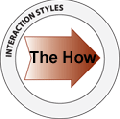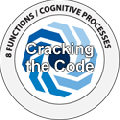Convergence of Models—The Whole Self
The 16 types are the sixteen personality type patterns that are often referred to by a 4-letter type code developed by Isabel Myers based on her understanding of the personality typology of Carl Jung. There are many ways of understanding these type patterns and many scholars have described these patterns from perspectives not based in Jungian typology. David Keirsey developed a model of temperament theory that looks at four core temperaments, each having four varieties—thus sixteen types. Bolton and Bolton expanded the social style model from four to sixteen types for which Linda Berens has further developed connections and has called Interaction Styles
Information on this page has been adapted from Linda V. Berens, Linda K. Ernst, and Melissa A. Smith, Quick Guide to the 16 Personality Types and Teams: Applying Team Essentials™ to Create Effective Teams (Telos Publications, 2004).
Myers Type Preferences
The type table on the right was created by Isabel Myers to display the types together that have the most in common. It is organized around the two middle letters in the type code called “function pairs.” These two letters refer to the preferred mode of perception and the preferred mode of judgment for that type pattern. Using Myers’ interpretation of Jung’s theories, the focus is on the columns of the type table. Many type practitioners group people by these function pairs in activities that highlight differences and points of conflict. Myers also wanted to put the two types that share a preference for the same dominant function in the same attitude next to each other. For example, ISTJ and ISFJ both have dominant introverted Sensing (Si) preferences and are side by side. Her system works if you think of the table as a cylinder that puts INTP and ISTP side by side and ENTJ and ESTJ side by side.
Temperament Theory [4 to 16]
As David Keirsey developed his theory of the four temperaments, he began to display them to show the aspects the four temperaments have in common. As Linda Berens expanded on his work, she began to consistently display the Idealist (the types with N and F in their type codes) and the Guardian (those with S and J in their codes) on the top of the matrix to show that these two temperaments have in common a social attitude—they tend to take more affiliative roles and focus on interdependence. The Rational temperament (with N and T in their codes) and the Artisan (with S and P in their codes) are on the bottom of the matrix to show that they have in common a more pragmatic, do-what-it-takes attitude that focuses on autonomy and independence. On the left are the two temperaments that tend to speak abstractly (Idealist and Rational) and on the right are the two that tend to speak in more tangible terms (Guardian and Artisan).
Interaction Styles [4 to 16]
The Interaction Styles model is based on observable behavior patterns of interaction with others, especially when we are trying to influence others. These patterns tell us the “how” of our behavior.
The Interaction Styles can be arranged in a matrix that describes their similarities and things in common. The left side of the matrix displays the types with a Directing communication style and a time and task focus. On the right side of the matrix are the types with an Informing communication style and a process and motivation focus. On the top of the matrix are the types who tend to take a Responding role with others, waiting to see what is happening before interacting. On the bottom of the matrix are the types who tend to take an Initiating role with others, making the first move. Diagonally, the types in the upper right-hand quadrant and the lower left-hand quadrant share an interest in control. The types in the upper left-hand quadrant and the lower right-hand quadrant share an interest in movement.
Cognitive Dynamics [Seeing the Pattern]
Cognitive Processes
Carl Jung identified eight cognitive processes (also called functions or mental processes). Each type code stands for a pattern of these eight cognitive processes. John Beebe, a modern Jungian analyst, developed a model of each of the patterns in terms of the archetypal role each process plays in the pattern. The table below lists the sixteen type patterns and some user-friendly terms for the roles of each process in each pattern.

